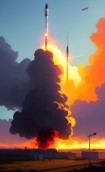|
QwertyAsher posted:Wouldn't you also run into a problem with the prospect of firing the GAU-8 with the rotors pointing up? My understanding, and this may be completely wrong, is that the a-10 had more than enough power from a single engine, but the act of firing the avenger was such a pile of newton's third law that it necessitated the second engine (In addition to the redundancy-boner that it is). It seems like firing something like that from a hovering platform would scoot you around like an air hockey puck
|
|
|
|

|
| # ? Jun 7, 2024 16:32 |
|
QwertyAsher posted:Wouldn't you also run into a problem with the prospect of firing the GAU-8 with the rotors pointing up? My understanding, and this may be completely wrong, is that the a-10 had more than enough power from a single engine, but the act of firing the avenger was such a pile of newton's third law that it necessitated the second engine (In addition to the redundancy-boner that it is). From wikipedia... A-10 MTOW: 50,000lb Empty weight: 24,959lb 2x CF34 9,065 lbf each CRJ-200, an infamously slow regional jet that often holds up traffic with poor performance Max take off weight: 51,000lb or 53,000 lb Empty weight: 30,000lb 2x CF34 9,220 lbf each Think about that for a second.
|
|
|
|
hobbesmaster posted:From wikipedia... Needs more engines.
|
|
|
|
The A-10 is going to be dropping alot of that weight..
|
|
|
oohhboy posted:The A-10 is going to be dropping alot of that weight.. Well, yes, it will lose a lot of its empty weight after breaking up from the SAM hit, but I don't see how that's relevant to the question of engine power.
|
|
|
|
|
blowfish posted:Needs more engines. Re-engine the B-52 with some GE-90s, strap a pair of GAU-8s under the nose, and use up whatever space is left on enough AGM-114s to blot out the sun.
|
|
|
|
Rent-A-Cop posted:gently caress it, let's go big with this.  Well, considering they've been using the B-52 as a makeshift ECM/ECCM platform for some time now, this makes sense. Loiter time, baby.
|
|
|
|
hobbesmaster posted:From wikipedia... that was more of a poorly delivered joke based on the understanding of the a-10 as an 8-year old who had worn through 2 vhs copies of Top Gun, my real (still probably stupid) question was how would a hovering osprey handle firing the gau-8
|
|
|
|
Rent-A-Cop posted:gently caress it, let's go big with this. AGM-114? AGM-86. I just want you to think big for christsake.
|
|
|
|
Parasite drones as ablative armor.
|
|
|
|
hobbesmaster posted:AGM-114? I agree, something with 5 miles of range seems a bit underpowered for something slung under a B-52. The plane would have to turn pretty hard to shoot the same place more than once. Throw in some Mavericks though, they weigh a bit less so you can blow up more weddings per mission 
|
|
|
|
Raenir Salazar posted:The junior officers who fought in WWII were pretty heavily shaped by their experiences from what I hear, so the allies don't have as much tactical weapons to fend off aircraft. So the US army fighting without any air support at all against an enemy WITH non-trivial aircraft would not end well. The chances of the U.S. going to war against an enemy with non-trivial aircraft are, themselves, trivial. The chances of such a conflict not escalating to the threat or use of nukes is BEYOND trivial. You're either in some fantasyland honest-to-god total war scenario, in which case nothing except nuclear-armed forces are relevant, or it's a war of choice that the U.S. is fighting on terms of their own choosing, in which case massed air-power is a luxury. There really is no middle ground between the two. Is the enemy nation or nations currently launching an invasion of a N.A.T.O. country? No? Then you've got yourself a war of choice. I'm sure that ground forces WOULD feel a lot more vulnerable without Zeus-like forward air controllers making anything or everything around them explode with a point of their finger. That seems to me to be a feature, not a bug. If a battle or campaign seems likely to result in heavy casualties but deployment of nuclear weaponry is not an option, it seems like the logical thing to do is NOT ENGAGE IN BATTLE, rather than pouring untold sums into making sure that if we "have to" fight such a war, it will be with few casualties and no fear of air attack.
|
|
|
|
What is flexible response?
|
|
|
|
Well your airforce just needs to be credible enough that it minimizes the chances of you having to resort to nuclear threats.
|
|
|
|
AlexanderCA posted:What is flexible response? Having options between "do nothing" and "nuke".
|
|
|
|
AlexanderCA posted:What is flexible response? Well you see our nukes have a handy feature called "dial a yield"
|
|
|
|
Torpor posted:Maybe I am misunderstanding you but if air dominance is so important why get the f-35? It isn't supposed to do that. It has even been described as useless without the f-22. The f-35 just isn't doing anything well, not even cutting down different spare parts. I wouldn't even argue that the jobs it is supposed to do are not worth the cost but that the f-35 isn't worth the cost.
|
|
|
|
Liberal_L33t posted:The chances of the U.S. going to war against an enemy with non-trivial aircraft are, themselves, trivial. On the other hand, the US is more and more likely to face adversaries with non-trivial air defenses. Airplanes don't have to be perfectly invisible to get through modern SAM systems; just a greater ability to penetrate enemy airspace before the enemy can fire on you opens up tons of opportunities to hit targets or attack the SAM systems directly.
|
|
|
|
hobbesmaster posted:Well you see our nukes have a handy feature called "dial a yield" If I ever found myself riding a bomber into the heart of the Soviet Union on a mission to end civilization, there is no way I wouldn't turn that poo poo up to 11 before I pickled, target package be damned.
|
|
|
|
blowfish posted:Having options between "do nothing" and "nuke". To be fair the Eisenhower administration's New Look policy was basically accepting that those were the options and that worked fairly well. Though a strategy that ends the world at the first sign of serious conflict is more than a little concerning.
|
|
|
|
blowfish posted:Having options between "do nothing" and "nuke".  Admittedly, a bad joke. If you're going to resort to nukes if some poo poo tier country fucks with you but has a basic air force, your policy is poo poo. I like Ike, but new look is dead for a reason.
|
|
|
|
^^ beatenBarlow posted:To be fair the Eisenhower administration's New Look policy was basically accepting that those were the options and that worked fairly well. Though a strategy that ends the world at the first sign of serious conflict is more than a little concerning. As long as everyone is on board with forfeiting every non-existential confrontation, sure. (Which, as it turns out, is an existential threat itself.)
|
|
|
|
Torpor posted:Maybe I am misunderstanding you but if air dominance is so important why get the f-35? It isn't supposed to do that. It has even been described as useless without the f-22. The f-35 just isn't doing anything well, not even cutting down different spare parts. I wouldn't even argue that the jobs it is supposed to do are not worth the cost but that the f-35 isn't worth the cost. Dead Reckoning already beat me to it, but yeah, it's because our options are "keep putting bubble gum and duct tape on increasingly obsolete aircraft" or nothing. Don't get me wrong, if I was king of DoD in the mid '90s/early 2000s, there's no way in hell I would've green lit JSF. As a basic concept it is questionable (particularly the -B...the fact that the SWAT effort had to be a thing should've been enough to kill the -B right there), but when you get into the nitty gritty details of execution the program was incredibly high risk...concurrency combined with a belief in computer modeling vs testing actual hardware is a recipe for disaster that unsurprisingly has blown up in everyone's faces. But I wasn't, and now we either deal with the hand we've been dealt or we keep SLEPing an aging fleet of aircraft that are literally falling out of the sky. Dead Reckoning posted:As long as everyone is on board with forfeiting every non-existential confrontation, sure. (Which, as it turns out, is an existential threat itself.) Yeah, and in today's day and age the idea that the US foreign policy establishment would suddenly turn over a new leaf and suddenly stop seeing every shithole country's internal problem and every two-bit terrorist as a literal existential crisis to the United States is pretty ludicrous (don't get me wrong, I'd love to see a bit more sobriety and reality injected into our foreign policy, I just don't see it happening anytime soon.) As long as we're going to see ourselves as the indispensable nation, entanglements are going to be a fact of life. And when a relatively minor country like Algeria can afford double-digit SAM systems, fighters designed in the 1970s just aren't going to cut it anymore. Also that's not getting into the deterrent effect conventional forces have to keep the lid on seemingly minor flashpoints that have the ability to blow up very quickly. Think the Spratlys for an example of this.
|
|
|
|
Dead Reckoning posted:Because the other options are: Luckily those two retarded options will be sorted out in some capacity when the next shithole is invaded. Just like The MRAP was quickly developed because troops were dying with insufficient support, and rolled out quickly, I see the resurgence of a low and slow aircraft based on operational needs. Of course not as fast to be put into production, and probably too late for the war it was created for, but back nonetheless.
|
|
|
|
Speaking of supersonic STOVL aircraft. Anyone here knows more of the Yak-41 than the wiki page?
|
|
|
|
Coldwar timewarp posted:Luckily those two retarded options will be sorted out in some capacity when the next shithole is invaded. Just like The MRAP was quickly developed because troops were dying with insufficient support, and rolled out quickly, I see the resurgence of a low and slow aircraft based on operational needs. Of course not as fast to be put into production, and probably too late for the war it was created for, but back nonetheless. Let's assume that you can bash together a cost-effective airframe and engines from existing designs and off-the-shelf components (because I know nothing about aircraft engineering). But we're talking about a CAS/strike plane, right? If the aircraft's mission requires it (and/or its weapons) to communicate with wingmates, air controllers, drones, satellites, and infantry... using encrypted data schemes and protocols whose specifications may not even be finalized yet... it seems like you're pretty much stuck in overbudget "development hell" no matter how good your intentions are. Also scope creep. "Low and slow aircraft based on operational needs." Whose needs? The Marines want a slightly slower version with improved loiter time and toughened landing gear and maybe buddy refueling. The Air Force will grudgingly allow the unsexy low-and-slow mission profile, but they want a rapid climb rate and high ceiling so that it can quickly redeploy between various low-and-slow engagements. The Navy insists on a zero/zero ejection seat which won't fit into the original cockpit design. And the Coast Guard wants side-scanning sonar and the ANG wants a Big Gulp cupholder and Canada has expressed an interest in an export version but only if it includes a second engine. Possibly relevant: Pierre Sprey posted:We wanted hot, light airplanes that were just as stripped-down as possible... They took an austere, stripped-down F-5 and ruined it by loading crap on it. Adding Sparrow missiles required huge complexity on the airplane.
|
|
|
|
Coldwar timewarp posted:Luckily those two retarded options will be sorted out in some capacity when the next shithole is invaded. Just like The MRAP was quickly developed because troops were dying with insufficient support, and rolled out quickly, I see the resurgence of a low and slow aircraft based on operational needs. Of course not as fast to be put into production, and probably too late for the war it was created for, but back nonetheless. Let's talk about MRAPs for a second. We spent literally like $45 billion to slightly increase mine protection for frontline infantry vehicles. By the time they were in major production, we were pulling back to our main bases in Iraq, and it turns out that a vehicle weighed down by several tons of armor is not super useful in a country like Afghanistan, where most of the transport infrastructure consists of unpaved dirt roads through the mountains. That's why most of them are either shrink wrapped in desert depots or being surplussed to law enforcement for pennies on the dollar. Great strategic vision there. To your other point, we actually did buy an entire fleet of low and slow aircraft based on operational needs. The U-28 and MC-12 (and Dragon Spear and Harvest Hawk and a handful of others) were developed primarily as a means of putting more platforms in the air to meet JFC demands. We were trying to buy turboprop attack aircraft too, and probably would have if the LAAR/LAS contract hadn't gotten bogged down in lawsuits and meddling. Let's not forget Predator and Reaper, which were the Air Force's number one priority by DoD fiat for several years. It turns out none of these platforms are super useful against anyone with an integrated air defense more advanced than "shoot DShKs and RPGs at the same time" and have a poo poo-ton of problems as a result of being rushed into operational use. So congrats, your prediction came true five years ago, and it pretty much sucked. EDIT: iyaayas01 posted:Also don't forget that one (of many) problems with these systems being rushed into service would be the serious issues with the MC-12's flight characteristics which, when combined with its practically non-existent training pipeline and cadre development, has resulted in people dying unnecessarily. Dead Reckoning fucked around with this message at 07:27 on Jan 27, 2015 |
|
|
|
GulMadred posted:and the ANG wants a Big Gulp cupholder lol this is perfect Dead Reckoning posted:Let's talk about MRAPs for a second. We spent literally like $45 billion to slightly increase mine protection for frontline infantry vehicles. By the time they were in major production, we were pulling back to our main bases in Iraq, and it turns out that a vehicle weighed down by several tons of armor is not super useful in a country like Afghanistan, where most of the transport infrastructure consists of unpaved dirt roads through the mountains. That's why most of them are either shrink wrapped in desert depots or being surplussed to law enforcement for pennies on the dollar. Great strategic vision there. No it's okay though because we then bought* a bunch more of slightly less heavy armored vehicles that were purpose built for use on Afghanistan's non-existent transportation infrastructure and they worked great. * For a nominal fee Except they still aren't useful outside of Afghanistan, to the point where we are leaving a bunch of them behind and torching them for scrap because that's still cheaper than paying to bring home a vehicle that costs a million dollars and change a piece. And of the ones we are bringing home, they're mostly going straight into mothballs. Dead Reckoning posted:To your other point, we actually did buy an entire fleet of low and slow aircraft based on operational needs. The U-28 and MC-12 (and Dragon Spear and Harvest Hawk and a handful of others) were developed primarily as a means of putting more platforms in the air to meet JFC demands. We were trying to buy turboprop attack aircraft too, and probably would have if the LAAR/LAS contract hadn't gotten bogged down in lawsuits and meddling. Let's not forget Predator and Reaper, which were the Air Force's number one priority by DoD fiat for several years. It turns out none of these platforms are super useful against anyone with an integrated air defense more advanced than "shoot DShKs and RPGs at the same time" and have a poo poo-ton of problems as a result of being rushed into operational use. Also don't forget that one (of many) problems with these systems being rushed into service would be the serious issues with the MC-12's flight characteristics which, when combined with its practically non-existent training pipeline and cadre development, has resulted in people dying unnecessarily. e: Here's a decent read about Indy 08 for anyone who's curious what I'm talking about with the MC-12. People should've gone to jail for how that abortion of a program was rushed through into service, but hey, urgent operational needs and the insatiable demand from the COCOMs for FMV ISR and all that. iyaayas01 fucked around with this message at 07:22 on Jan 27, 2015 |
|
|
|
MRAPs drastically increased mine protection, and for all the money we set on fire on our defense generally and Iraq specifically, that seems like a weird bone to pick. That they're too heavy to take back argues for invading fewer people, since IEDs are the future of asymmetric warfare and consequently we will have some variant of MRAPs in all future contested occupations.
|
|
|
|
Best Friends posted:MRAPs drastically increased mine protection, and for all the money we set on fire on our defense generally and Iraq specifically, that seems like a weird bone to pick. That they're too heavy to take back argues for invading fewer people, since IEDs are the future of asymmetric warfare and consequently we will have some variant of MRAPs in all future contested occupations. It's more an example of how "just wait until urgent operational needs drive a requirement" isn't a particularly good approach to take to acquisitions, especially when we're talking something that is considerably more complex than a truck with some armor and a v-hull strapped onto it. I mean to continue with the MRAP thing, they're a logistical configuration management nightmare...we bought something like 15 different models from 7 different manufacturers.
|
|
|
|
Dead Reckoning posted:Let's talk about MRAPs for a second. We spent literally like $45 billion to slightly increase mine protection for frontline infantry vehicles. By the time they were in major production, we were pulling back to our main bases in Iraq, and it turns out that a vehicle weighed down by several tons of armor is not super useful in a country like Afghanistan, where most of the transport infrastructure consists of unpaved dirt roads through the mountains. That's why most of them are either shrink wrapped in desert depots or being surplussed to law enforcement for pennies on the dollar. Great strategic vision there. MRAPs had some serious issues with off road capability in Afghanistan, but that "slight increase" in mine protection probably saved my life, and I kind of expect a bit of a poo poo show when the Army panic buys things in the middle of a war. The MATVs were loving awesome though.
|
|
|
|
Liberal_L33t posted:The chances of the U.S. going to war against an enemy with non-trivial aircraft are, themselves, trivial. The chances of such a conflict not escalating to the threat or use of nukes is BEYOND trivial. I think you like, totally didn't understand my post.
|
|
|
|
Liberal_L33t posted:The chances of the U.S. going to war against an enemy with non-trivial aircraft are, themselves, trivial. The chances of such a conflict not escalating to the threat or use of nukes is BEYOND trivial. I think you have some misapprehensions about what a nation's military does for it in peacetime. The best military equipment is the kind you never have to use (insert Sun Tzu quote here); just by existing it shapes and constrains the behavior of other nations. For example, the Chinese DF-21 ASBM (within a larger A2/AD framework) has had the effect of undermining the plausibility of US military commitments to Japan. Where the Seventh Fleet could once more or less go where it pleased, it now has to consider the possibility that any show of force in the first island chain puts the fleet in a position of serious vulnerability. The US has hardware and CONOPS (Air-Sea Battle) aimed at redressing this, but even if ASB works 100%, the kind of show of force exhibited during the TTSC now has far greater costs and risks associated with it. This is a very significant strategic result achieved by the PRC, all without having to actually go to war. You also seem to subscribe to Thomas Friedman's theory of the "the golden straightjacket." It's the idea that globalization (!) has all but eliminated the possibility of war between major powers. It's no doubt true that economic interdependence is a huge incentive not to go to war, or engage in strategic competition. The problem with the theory is it discounts the extent to which states can misperceive the reality of their own strategic circumstances. Nations misread each other all the time, and it's very easy (and politically convenient) to overestimate the extent to which the "straightjacket" has a constraining effect on the other guy. So, you can imagine a scenario where two countries push their own strategic interests, convinced that the forces which should constrain them both actually gives them an advantage. The golden straightjacket idea also seems to requires us to accept two massively ahistorical premises: that no one ever went to war when it wasn't in their best interest, and that there's nothing a nation would risk annihilation for. Problems with "New Look" were already discussed. Further reading: http://www.dtic.mil/dtic/tr/fulltext/u2/a156061.pdf http://www.rand.org/content/dam/rand/pubs/commercial_books/2007/RAND_CB137-1.pdf
|
|
|
|
The idea that globalization had removed the threat of a war between major powers was the predominant mindset in the period preceding the First World War.
|
|
|
|
Aren't military logistics normally a nightmare? Or do you mean an extra nightmare?
|
|
|
|
Dilkington posted:The golden straightjacket When I was taking a political science class circa 2001, I remember that there was some movement behind the theory that spreading democracy was a good thing because democracies do not go to war with each other. I am curious if that theory is now completely dead, or if they just redefined the meaning of war or democracy. The "golden straightjacket" reminds me of that theory. It's true until it isn't.
|
|
|
Chuu posted:When I was taking a political science class circa 2001, I remember that there was some movement behind the theory that spreading democracy was a good thing because democracies do not go to war with each other. I am curious if that theory is now completely dead, or if they just redefined the meaning of war or democracy. You could still make a reasonable argument on the basis of 'much less likely to go to war', but that argument was ahistorical even in 2001. It's just an extension of the Fukayamean pre 9/11 hubris.
|
|
|
|
|
Torpor posted:Aren't military logistics normally a nightmare? Or do you mean an extra nightmare? I don't have any first-hand knowledge, but just from an outsider with experience looking in perspective it would appear to be quite a bit worse than usual. I mean you've got all the typical problems except now instead of your system consisting of one or maybe two or at most three different versions being made by one prime contractor plus a couple of subs, you've got one "system" that is manufactured by 7 (or so) different companies manufacturing 15 (or so) primary different versions, most of which are completely different systems from each other. fake edit: yeah, looks like I wasn't too far off the mark. When you're reading that story, keep in mind that "we overcame some challenges" is military PA speak for "we threw a shitload of money at the problem, then when that didn't work we gave up and paid some contractors a shitload more money to do whatever needed doing."
|
|
|
|
Chuu posted:When I was taking a political science class circa 2001, I remember that there was some movement behind the theory that spreading democracy was a good thing because democracies do not go to war with each other. I am curious if that theory is now completely dead, or if they just redefined the meaning of war or democracy. The US overthrew lots of democracies during the Cold War, and just off the top of my head Lebanon and Israel both go to war all the loving time.
|
|
|
|

|
| # ? Jun 7, 2024 16:32 |
|
Rand alPaul posted:The US overthrew lots of democracies during the Cold War, and just off the top of my head Lebanon and Israel both go to war all the loving time. The essential argument is that democracies do not go to war (and those who say that are probably using a definition of war that excludes covertly overthrowing elected governments like the ones overthrown during the Cold War) with each other. Not that they do not go to war. When I was in college people heavily referenced this: http://carnegie.org/fileadmin/Media...Imperatives.pdf Money graph: The experience of this century offers important lessons. Countries that govern themselves in a truly democratic fashion do not go to war with one another. They do not aggress against their neighbors to aggrandize themselves or glorify their leaders. Democratic governments do not ethnically "cleanse" their own populations, and they are much less likely to face ethnic insurgency. Democracies do not sponsor terrorism against one another. They do not build weapons of mass destruction to use on or to threaten one another. Democratic countries form more reliable, open, and enduring trading partnerships. In the long run they offer better and more stable climates for investment. They are more environmentally responsible because they must answer to their own citizens, who organize to protest the destruction of their environments. They are better bets to honor international treaties since they value legal obligations and because their openness makes it much more difficult to breach agreements in secret. Precisely because, within their own borders, they respect competition, civil liberties, property rights, and the rule of law, democracies are the only reliable foundation on which a new world order of international security and prosperity can be built.
|
|
|





 I CANNOT EJACULATE WITHOUT SEEING NATIVE AMERICANS BRUTALISED!
I CANNOT EJACULATE WITHOUT SEEING NATIVE AMERICANS BRUTALISED!






















